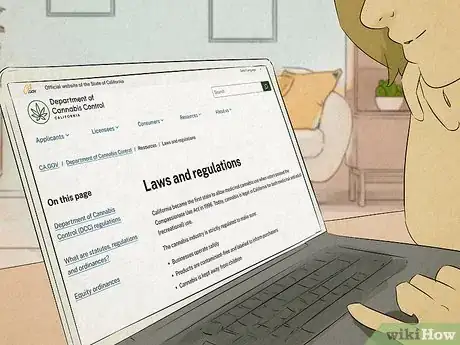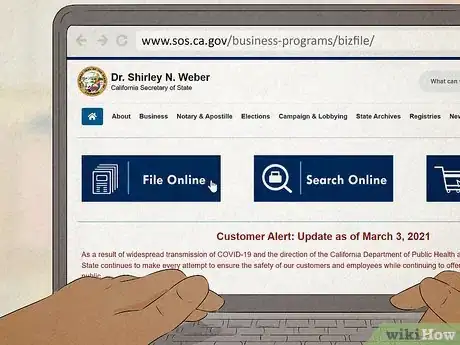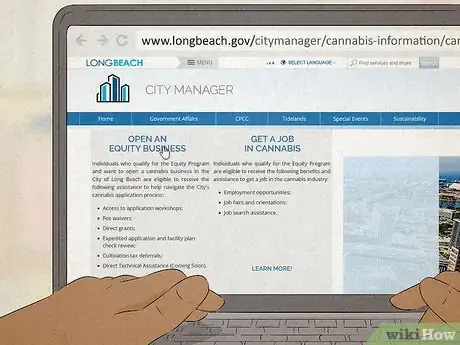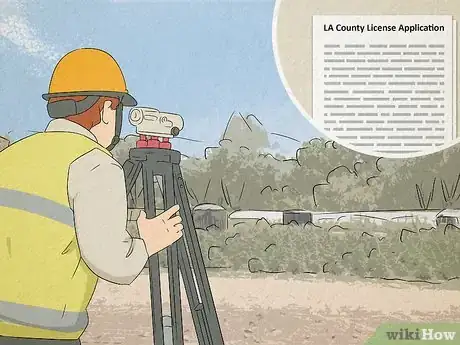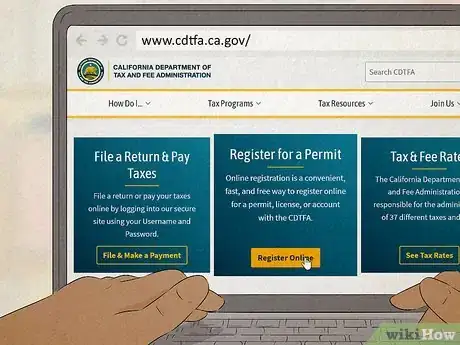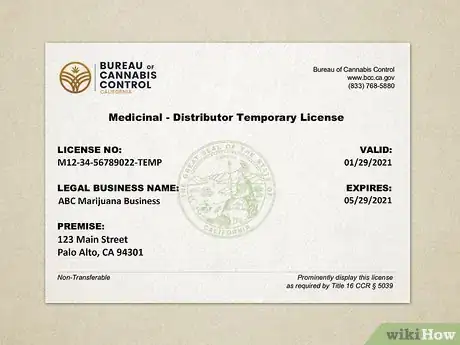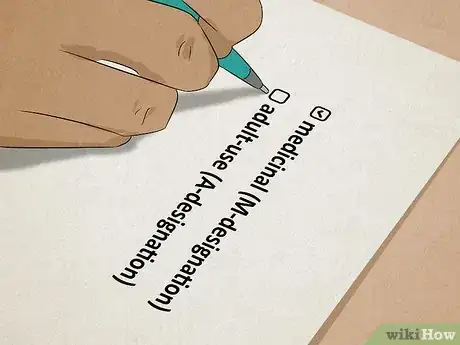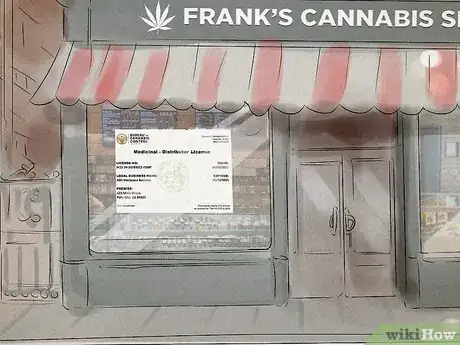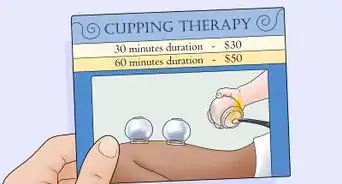This article was co-authored by Jamie Corroon, ND, MPH. Dr. Jamie Corroon, ND, MPH is the founder and Medical Director of the Center for Medical Cannabis Education. Dr. Corroon is a licensed Naturopathic Doctor and clinical researcher. In addition to clinical practice, Dr. Corroon advises dietary supplement and cannabis companies regarding science, regulation, and product development. He is well published in the peer-review literature, with recent publications that investigate the clinical and public health implications of the broadening acceptance of cannabis in society. He earned a Masters in Public Health (MPH) in Epidemiology from San Diego State University. He also earned a Doctor of Naturopathic Medicine degree from Bastyr University, subsequently completed two years of residency at the Bastyr Center for Natural Health, and is a former adjunct professor at Bastyr University California.
There are 16 references cited in this article, which can be found at the bottom of the page.
This article has been viewed 16,492 times.
Starting a marijuana edibles business in California can be easier than trying to break into the cannabis industry as a grower. While you’ll still have to go through a local and state licensing process for manufacturing and distributing cannabis products, you won’t have to deal with the hefty costs and licenses associated with cultivating cannabis plants themselves. As of 2017, California only has one regulatory package for both medical marijuana business and adult-use marijuana businesses.[1] As a result, the registration and licensing processes for edibles businesses in California are nearly identical–whether you intend to sell products for medical use or not! We’ll walk you through a step-by-step guide to starting your own cannabis edibles business in California.
Steps
Business Organization
-
1Check your local ordinances.[2] While Proposition 64 legalized marijuana in California, many cities and counties have their own ordinances which might prohibit cultivating, manufacturing, or selling cannabis products (medical or non-medical). Before you start up your business, search “cannabis ordinances” with your city and county name online to make sure your edibles business will be legal.[3]
-
2Register your business with the California Secretary of State. Pick a memorable, unique business name for your edibles business. Then, decide whether to register your business as a Corporation (including for profit and nonprofit), Limited Liability Company (LLC), Limited Liability Partnership (LP) or Sole Proprietorship (SP). Each entity type involves a different tax structure and level of personal liability–the California Secretary of State website can help you choose which one is best for you![4]
- You’ll fill out a Statement of Registration first, then you have 90 days to fill out a Statement of Information form.[5]
- Sole proprietorships do not have to register.
- Pay $75 to register as an LLC and $105 to register as a corporation.
- You can incorporate as a nonprofit, but cannabis industry nonprofits are not tax exempt in California.[6]
- Go to https://www.sos.ca.gov/business-programs/bizfile/ to register.
Advertisement -
3Create a business plan. In a business plan, you’ll provide a brief description of your company’s operations, organizational structure, competitors, the products you’ll offer, and your marketing/sales strategies. For marijuana businesses, it’s crucial to have a detailed business plan, since it’ll help you secure funding (which we’ll talk about next).
- For your edibles business, consider whether you plan to produce your own edibles or simply rebrand other people’s products and sell them. The state sees you as a “manufacturer” either way, but creating products vs. repackaging will affect the types of suppliers you pursue.[7]
- For instance, you’ll seek out co-packers if you plan to label and rebrand edibles, but you’ll purchase wholesale cannabis oil/plant products if you make the edibles yourself.
-
4Secure private funding or get a grant through a social equity program. Since cannabis is federally-illegal (though permitted in California), major banks will not give loans to cannabis sellers.[8] Seek out third-party investors, and create a pitch about the value your business can deliver.
- Certain cities/counties give priority application status and even grants to applicants who were negatively impacted by the War on Drugs and the criminalization of cannabis.[9]
- Cities supporting “equity applicants” (and potentially giving grants) include Humboldt County, Coachella, Rio Dell, Long Beach, Los Angeles, Oakland, Sacramento, the City and County of San Francisco, and San Jose.
- Apply for grants via your city's website or search for your city's "cannabis social equity program."
- On average, it costs around $250,000 to start an edibles business legally and maintain it through the first year of operations.[10]
Local Licensing for a Medical Marijuana Business
-
1Find a property that fits with local zoning laws. While you won't need to worry about obtaining a greenhouse or growing site, you will need to consider whether your city allows dispensaries or cannabis product manufacturers. Statewide, cannabis businesses cannot be within a 600-foot radius of a K-12 school or day care facility. Your local city or county may require your business to be even further away.[11]
- In the state of California, cannabis businesses can’t be in a private residence or require people to pass through a place that sells alcohol or tobacco.
- Remember that licensed businesses must comply with regulations that promote safety and product quality. [12]
-
2Prepare documentation of your business operations. Every city and county will require a slightly different list of documents for you to get a permit. Most will require you to describe how you’ll store and dispose of any chemicals, how you’ll keep the cannabis secure, and how you’ll ensure “Medical Use Only” marijuana edibles only go to medical marijuana users.[13]
- You may also have to describe how you prepare and test your products to make sure they’re safe.
-
3Apply for a city and/or county license. California requires you to obtain local licensing before you can apply for a state license.[14] Licensing requirements typically include an inspection of your premises, fingerprinting, assembly permits, zoning checks, and more.[15]
- Local fees vary widely, but you can expect to pay thousands of dollars.
- For instance, total initial fees in the City of Santa Cruz are around $2,000 for a medical marijuana business whereas fees in the City/County of San Francisco are around $12,500.
State Licensing for Manufacturing and Selling Edibles
-
1Register with the California Department of Tax and Fee Administration (CDTFA). If you’re cultivating, processing, manufacturing, selling, or distributing cannabis, you need to get a seller’s permit from the CDTFA before you can apply for a license with the Department of Cannabis Control. If you’re planning to distribute cannabis as well as manufacture it, you must also register for a cannabis tax permit in addition to a seller’s permit.[16]
- There is no charge for a California seller’s permit or tax permit.[17]
- If you distribute cannabis, you’ll pay two cannabis taxes (from the cultivator and from the customer) to the CDTFA.
-
2Get licensed by the California Department of Cannabis Control. If you’re planning on manufacturing your own edibles and extracting cannabis oil/products yourself, you’ll need a Type 6 or Type 7 license. If you’re planning on infusing cannabis oil or plant material into products, you can get a Type N license. If you want to repackage cannabis products, you’ll get a Type P license. In addition to a Type 6, 7, N, or P license, you’ll need a Type 10 license to have a storefront or a Type 9 license to sell online/via delivery.[18]
- Pick Type 9 over Type 10 if local zoning laws make rent prohibitively high or don’t allow physical dispensaries at all.
- These permits typically cost upwards of $2,000. For instance, you’ll pay $2,500 for a Type 10 retailer license if your business has a gross revenue of $500,000 or less.[19]
- As your revenue increases, you’ll pay up to $96,600 for an annual license (for businesses with multi-million dollar revenue).
-
3Choose an M-designation on your license to manufacture and sell “Medical Use Only” products. During the licensing process, you can specify whether you’d like to designate your business as medicinal (M-designation), adult-use (A-designation), or both. Due to the Medicinal and Adult-Use Cannabis Regulation and Safety Act (MAUCRSA) passed in 2017, licensing for M-designated dispensaries and A-designated dispensaries is the same. However, the THC limits for medical-use products versus non medical-use products are different.[20]
- Medical-use designated edibles cannot contain more than 500 milligrams of THC per package.[21]
- Non-medical edibles cannot contain more than 100 milligrams of THC per package.[22]
- If you have an M-designation, you must clearly label your “Medical Use Only” products and can only sell them to customers with a medical marijuana license. Patients must be qualified by a healthcare professional per the state’s medical marijuana program, which requires an evaluation of the patient’s past medical history and current complaints.[23]
-
4Post your license in a visible place.[24] Download your certificate from the licensing system and place it in your storefront (or manufacturing facility if you’re not a brick-and-mortar distributor). After you’ve gone through the effort of getting all your permits and meeting requirements, you want authorities and customers to know that your business is legal![25]
- Your license is good for one year.
References
- ↑ https://cannabis.ca.gov/2017/09/29/licensing-authorities-announce-withdrawal-of-proposed-medical-cannabis-regulations/
- ↑ Jamie Corroon, ND, MPH. Medical Director of the Center for Medical Cannabis Education. Expert Interview. 10 March 2020.
- ↑ https://saclaw.org/articles/marijuana-laws-in-california-edl/
- ↑ https://www.sos.ca.gov/business-programs/business-entities/starting-business/types
- ↑ https://bpd.cdn.sos.ca.gov/cannabizfile/10steps2.pdf
- ↑ https://www.ftb.ca.gov/tax-pros/law/cannabis-tax-law-and-legislation.html
- ↑ https://cannabis.ca.gov/wp-content/uploads/sites/2/2021/07/Regulations_Section100_2021-0615-07N.pdf
- ↑ https://www.nerdwallet.com/article/small-business/how-to-start-a-marijuana-business
- ↑ https://business.ca.gov/cannabis-equity-grants-program-for-local-jurisdictions/
- ↑ https://www.finder.com/how-to-legally-start-a-cannabis-business
- ↑ https://cannabis.ca.gov/wp-content/uploads/sites/2/2021/07/Regulations_Section100_2021-0615-07N.pdf
- ↑ Jamie Corroon, ND, MPH. Medical Director of the Center for Medical Cannabis Education. Expert Interview. 10 March 2020.
- ↑ https://humboldtgov.org/DocumentCenter/View/56090/Dispensary-Application-Checklist--8-19-16
- ↑ https://bpd.cdn.sos.ca.gov/cannabizfile/10steps2.pdf
- ↑ https://www.sandiego.gov/sites/default/files/legacy/iba/pdf/10_15a.pdf
- ↑ https://bpd.cdn.sos.ca.gov/cannabizfile/10steps2.pdf
- ↑ https://www.cdtfa.ca.gov/formspubs/pub107/
- ↑ https://cannabis.ca.gov/applicants/license-types/
- ↑ https://cannabis.ca.gov/wp-content/uploads/sites/2/2021/07/Regulations_Section100_2021-0615-07N.pdf
- ↑ https://cannabis.ca.gov/wp-content/uploads/sites/2/2021/07/Regulations_Section100_2021-0615-07N.pdf
- ↑ https://cannabis.ca.gov/wp-content/uploads/sites/2/2021/07/Regulations_Section100_2021-0615-07N.pdf
- ↑ https://cannabis.ca.gov/2018/06/06/transition-period-requirements/
- ↑ Jamie Corroon, ND, MPH. Medical Director of the Center for Medical Cannabis Education. Expert Interview. 10 March 2020.
- ↑ Jamie Corroon, ND, MPH. Medical Director of the Center for Medical Cannabis Education. Expert Interview. 10 March 2020.
- ↑ https://cannabis.ca.gov/applicants/how-to-apply-renew/
